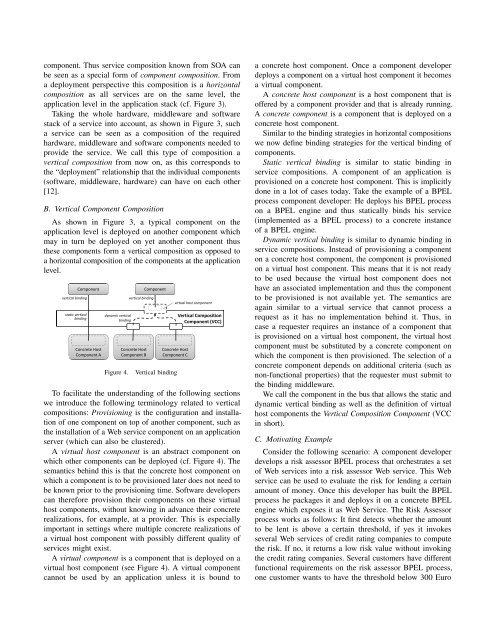Combining horizontal and vertical composition of services ... - IAAS
Combining horizontal and vertical composition of services ... - IAAS
Combining horizontal and vertical composition of services ... - IAAS
Create successful ePaper yourself
Turn your PDF publications into a flip-book with our unique Google optimized e-Paper software.
component. Thus service <strong>composition</strong> known from SOA can<br />
be seen as a special form <strong>of</strong> component <strong>composition</strong>. From<br />
a deployment perspective this <strong>composition</strong> is a <strong>horizontal</strong><br />
<strong>composition</strong> as all <strong>services</strong> are on the same level, the<br />
application level in the application stack (cf. Figure 3).<br />
Taking the whole hardware, middleware <strong>and</strong> s<strong>of</strong>tware<br />
stack <strong>of</strong> a service into account, as shown in Figure 3, such<br />
a service can be seen as a <strong>composition</strong> <strong>of</strong> the required<br />
hardware, middleware <strong>and</strong> s<strong>of</strong>tware components needed to<br />
provide the service. We call this type <strong>of</strong> <strong>composition</strong> a<br />
<strong>vertical</strong> <strong>composition</strong> from now on, as this corresponds to<br />
the “deployment” relationship that the individual components<br />
(s<strong>of</strong>tware, middleware, hardware) can have on each other<br />
[12].<br />
B. Vertical Component Composition<br />
As shown in Figure 3, a typical component on the<br />
application level is deployed on another component which<br />
may in turn be deployed on yet another component thus<br />
these components form a <strong>vertical</strong> <strong>composition</strong> as opposed to<br />
a <strong>horizontal</strong> <strong>composition</strong> <strong>of</strong> the components at the application<br />
level.<br />
<strong>vertical</strong> binding<br />
static <strong>vertical</strong><br />
binding<br />
Component<br />
Concrete Host<br />
Component A<br />
dynamic <strong>vertical</strong><br />
binding<br />
Figure 4.<br />
<strong>vertical</strong> binding<br />
Concrete Host<br />
Component B<br />
Component<br />
virtual host component<br />
Concrete Host<br />
Component C<br />
Vertical binding<br />
Vertical Composition<br />
Component (VCC)<br />
To facilitate the underst<strong>and</strong>ing <strong>of</strong> the following sections<br />
we introduce the following terminology related to <strong>vertical</strong><br />
<strong>composition</strong>s: Provisioning is the configuration <strong>and</strong> installation<br />
<strong>of</strong> one component on top <strong>of</strong> another component, such as<br />
the installation <strong>of</strong> a Web service component on an application<br />
server (which can also be clustered).<br />
A virtual host component is an abstract component on<br />
which other components can be deployed (cf. Figure 4). The<br />
semantics behind this is that the concrete host component on<br />
which a component is to be provisioned later does not need to<br />
be known prior to the provisioning time. S<strong>of</strong>tware developers<br />
can therefore provision their components on these virtual<br />
host components, without knowing in advance their concrete<br />
realizations, for example, at a provider. This is especially<br />
important in settings where multiple concrete realizations <strong>of</strong><br />
a virtual host component with possibly different quality <strong>of</strong><br />
<strong>services</strong> might exist.<br />
A virtual component is a component that is deployed on a<br />
virtual host component (see Figure 4). A virtual component<br />
cannot be used by an application unless it is bound to<br />
a concrete host component. Once a component developer<br />
deploys a component on a virtual host component it becomes<br />
a virtual component.<br />
A concrete host component is a host component that is<br />
<strong>of</strong>fered by a component provider <strong>and</strong> that is already running.<br />
A concrete component is a component that is deployed on a<br />
concrete host component.<br />
Similar to the binding strategies in <strong>horizontal</strong> <strong>composition</strong>s<br />
we now define binding strategies for the <strong>vertical</strong> binding <strong>of</strong><br />
components.<br />
Static <strong>vertical</strong> binding is similar to static binding in<br />
service <strong>composition</strong>s. A component <strong>of</strong> an application is<br />
provisioned on a concrete host component. This is implicitly<br />
done in a lot <strong>of</strong> cases today. Take the example <strong>of</strong> a BPEL<br />
process component developer: He deploys his BPEL process<br />
on a BPEL engine <strong>and</strong> thus statically binds his service<br />
(implemented as a BPEL process) to a concrete instance<br />
<strong>of</strong> a BPEL engine.<br />
Dynamic <strong>vertical</strong> binding is similar to dynamic binding in<br />
service <strong>composition</strong>s. Instead <strong>of</strong> provisioning a component<br />
on a concrete host component, the component is provisioned<br />
on a virtual host component. This means that it is not ready<br />
to be used because the virtual host component does not<br />
have an associated implementation <strong>and</strong> thus the component<br />
to be provisioned is not available yet. The semantics are<br />
again similar to a virtual service that cannot process a<br />
request as it has no implementation behind it. Thus, in<br />
case a requester requires an instance <strong>of</strong> a component that<br />
is provisioned on a virtual host component, the virtual host<br />
component must be substituted by a concrete component on<br />
which the component is then provisioned. The selection <strong>of</strong> a<br />
concrete component depends on additional criteria (such as<br />
non-functional properties) that the requester must submit to<br />
the binding middleware.<br />
We call the component in the bus that allows the static <strong>and</strong><br />
dynamic <strong>vertical</strong> binding as well as the definition <strong>of</strong> virtual<br />
host components the Vertical Composition Component (VCC<br />
in short).<br />
C. Motivating Example<br />
Consider the following scenario: A component developer<br />
develops a risk assessor BPEL process that orchestrates a set<br />
<strong>of</strong> Web <strong>services</strong> into a risk assessor Web service. This Web<br />
service can be used to evaluate the risk for lending a certain<br />
amount <strong>of</strong> money. Once this developer has built the BPEL<br />
process he packages it <strong>and</strong> deploys it on a concrete BPEL<br />
engine which exposes it as Web Service. The Risk Assessor<br />
process works as follows: It first detects whether the amount<br />
to be lent is above a certain threshold, if yes it invokes<br />
several Web <strong>services</strong> <strong>of</strong> credit rating companies to compute<br />
the risk. If no, it returns a low risk value without invoking<br />
the credit rating companies. Several customers have different<br />
functional requirements on the risk assessor BPEL process,<br />
one customer wants to have the threshold below 300 Euro
















